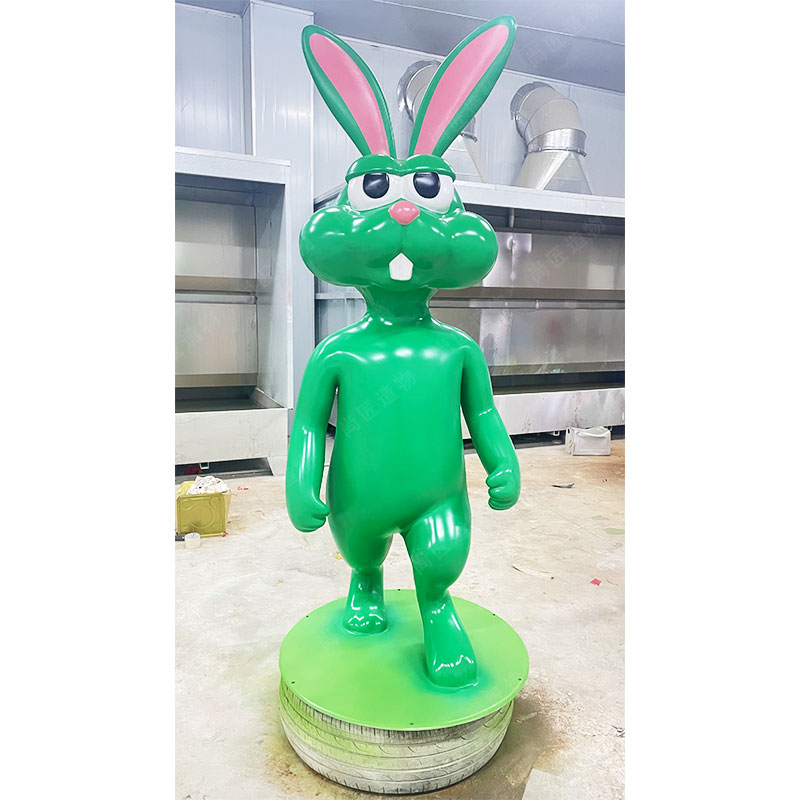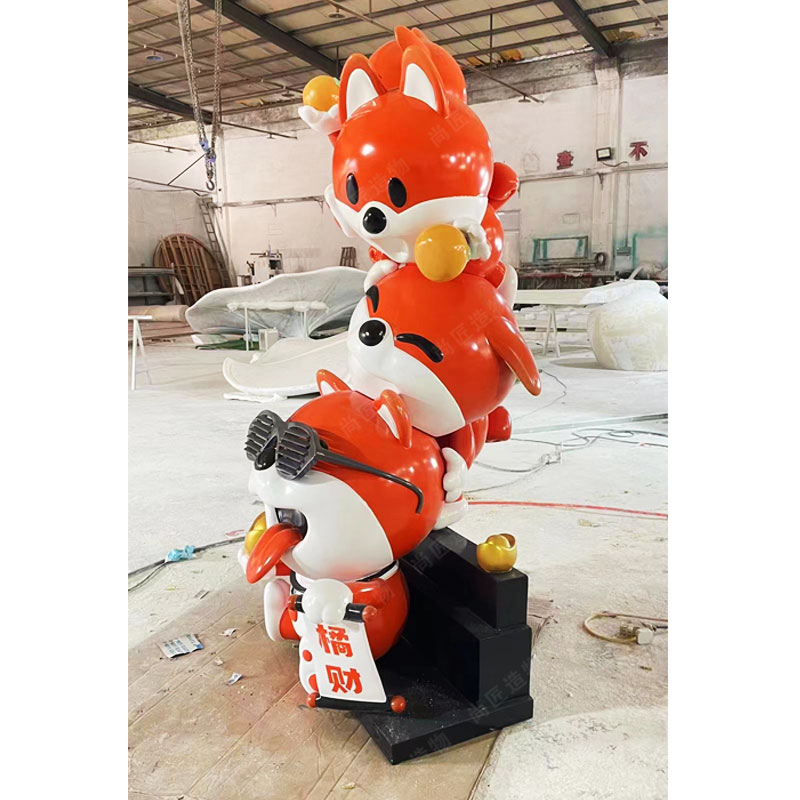Key Takeaways
Proper installation of FRP sculptures outdoors requires attention to anchoring, weatherproofing, and long-term maintenance. Fiberglass-reinforced polymer (FRP) is lightweight yet durable, but improper setup can lead to instability or weather-related damage. Below are critical considerations for ensuring your sculpture remains secure and visually appealing in any climate.
| Installation Factor | Key Consideration | Recommended Action |
|---|---|---|
| Anchoring Method | Soil type, wind exposure | Use galvanized steel anchors for soft soil; concrete footings for high-wind areas |
| Weatherproofing | UV resistance, moisture | Apply marine-grade epoxy coatings annually; seal joints with silicone caulk |
| Base Preparation | Drainage, stability | Install gravel layers beneath the base; ensure 10-15° slope for water runoff |
"Anchoring FRP sculptures isn’t just about weight—it’s about balancing flexibility and rigidity to withstand environmental stress." — Landscape Architect, Public Art Digest
For sculptures in coastal or humid regions, consider adding anti-corrosion bolts to metal fittings. Lightweight Cartoon sculpture designs may require additional ballast, such as sand-filled bases, to prevent tipping.
Pro Tip: Conduct seasonal inspections to check for cracks or coating wear, especially after extreme weather. Address minor repairs immediately to avoid costly restoration later.
By integrating these strategies, FRP sculptures can maintain structural integrity and aesthetic quality for decades, even in challenging outdoor environments.

Outdoor FRP Sculpture Installation Guide
Proper installation of FRP (fiberglass-reinforced polymer) sculptures outdoors ensures longevity and stability in diverse climates. Begin by selecting a level, stable surface free of drainage issues. Concrete slabs or compacted gravel bases are ideal for preventing shifting. For anchoring, use stainless steel brackets or threaded rods embedded into the sculpture’s internal framework, securing them to a concrete footing. This method distributes weight evenly and resists wind uplift.
Incorporate expansion joints if installing in regions with temperature fluctuations to accommodate material contraction and expansion. For sculptures with moving parts, such as kinetic sculptures, ensure mounting hardware allows controlled motion without compromising structural integrity. Apply a weather-resistant sealant to all seams and joints to prevent moisture intrusion, which can weaken fiberglass over time.
Avoid direct ground contact by elevating the sculpture on a non-corrosive pedestal. Regularly inspect anchor points and hardware for corrosion, tightening or replacing components as needed. Pair these steps with UV-resistant coatings to protect against sun damage. By prioritizing precise anchoring and proactive weatherproofing, FRP sculptures maintain their aesthetic and structural quality through seasonal changes.

Anchoring Fiberglass Art for Durability
Proper anchoring is critical to ensuring FRP sculptures withstand outdoor elements. Begin by selecting a foundation type based on the sculpture’s size and local climate. For smaller pieces, concrete footings embedded 12–18 inches below frost lines prevent shifting during freeze-thaw cycles. Larger installations may require ground anchors or steel rebar frames bolted to pre-cured concrete slabs.
Use corrosion-resistant hardware, such as stainless steel brackets, to attach the sculpture to its base. Avoid direct contact between fiberglass and metal by inserting rubber or nylon spacers, reducing wear from vibration. For windy areas, cross-bracing with tension cables adds lateral stability without compromising aesthetics.
Always assess soil composition and drainage before installation—sandy or loose soils may need compacted gravel layers to improve load-bearing capacity. Test anchor points periodically, especially after extreme weather, and adjust tension as needed. Combining robust anchoring with site-specific adjustments ensures sculptures remain secure while preserving their structural integrity over time. This foundational work sets the stage for effective weatherproofing, covered in the next section.
Weatherproofing Techniques for FRP Statues
Protecting fiberglass-reinforced polymer (FRP) sculptures from environmental damage requires a layered approach to weatherproofing. Begin by applying a high-quality marine-grade polyurethane sealant to all joints, seams, and surface imperfections, as these areas are vulnerable to moisture infiltration. For UV resistance, use a two-part epoxy primer followed by an acrylic urethane topcoat, which reflects sunlight and prevents fading. To combat mold and mildew in humid climates, incorporate a biostatic additive into the final clear coat.
Routine maintenance plays a critical role—clean surfaces quarterly with a mild detergent and soft brush to remove dirt and pollutants that degrade protective layers. Pay special attention to Realistic sculpture designs with intricate textures, where debris can accumulate. In regions with freeze-thaw cycles, ensure drainage holes at the sculpture’s base remain unblocked to prevent water pooling and cracking. For added durability in coastal areas, consider annual reapplication of salt-resistant sealants. These steps, combined with proper anchoring and base preparation, create a comprehensive defense system against weather-related wear.

Climate-Resistant Sculpture Mounting Tips
When installing FRP sculptures in climates with extreme temperature shifts, high humidity, or salt-laden air, specialized mounting strategies become essential. Start by evaluating local weather patterns—areas prone to hurricanes require different anchoring than regions with heavy snowfall. For coastal zones, use marine-grade stainless steel hardware to combat corrosion, and pair it with epoxy-coated anchor rods embedded in reinforced concrete footings. In freeze-thaw cycles, elevate sculptures slightly above ground level using adjustable pedestals to prevent water pooling and ice damage.
Thermal expansion is a critical factor: leave a 1/8-inch gap between mounting brackets and fiberglass surfaces to accommodate material movement without stress fractures. For UV protection, integrate mounting points beneath overhangs or within recessed bases, supplementing with UV-resistant sealants at connection joints. In wind-prone areas, cross-bracing with aircraft-grade cables adds lateral stability without compromising aesthetics.
A fiberglass sculpture installation’s success hinges on balancing structural rigidity with material flexibility. Always conduct seasonal inspections of mounting hardware, tightening components before storm seasons and reapplying anti-seize lubricants annually. This proactive approach ensures climate challenges enhance—rather than endanger—your outdoor art’s longevity.

Securing Fiberglass in Harsh Weather
Extreme weather demands specialized strategies to keep fiberglass sculptures stable and intact. Begin by selecting corrosion-resistant anchoring materials, such as stainless steel threaded rods or galvanized bolts, which resist rust in humid or coastal environments. For high-wind zones, embed sculptures into concrete foundations using expansion anchors, ensuring at least 30% of the sculpture’s height is submerged for optimal stability. In frost-prone areas, extend anchor depth below the frost line to prevent ground shifts from tilting or cracking the base.
Ground conditions also play a critical role. Use polymeric sand or gravel around the sculpture’s base to improve drainage and reduce soil erosion during heavy rains. For added protection, apply UV-resistant sealants to exposed surfaces and reinforce joints with marine-grade epoxy to prevent moisture infiltration. In hurricane- or tornado-prone regions, consider temporary removal or secondary support systems like steel frames during peak storm seasons.
Regularly inspect anchor points and seals, especially after severe weather events. Small cracks or loosened bolts can escalate into structural failures if left unaddressed. For sculptures in saltwater-rich climates, rinse surfaces monthly to prevent salt buildup, which accelerates material degradation. Integrating these measures ensures fiberglass art withstands nature’s challenges while maintaining its aesthetic appeal. IP character sculpture installations, for example, often employ hybrid anchoring systems tailored to regional climate risks.

Long-Term FRP Sculpture Care Strategies
While proper installation lays the foundation for outdoor FRP sculptures, consistent maintenance ensures their longevity. Begin by establishing a routine cleaning schedule—use a mild detergent and soft-bristle brush to remove dirt, pollutants, or organic growth without scratching the gel coat. For regions with heavy rainfall or humidity, apply a UV-resistant automotive wax every 12–18 months to protect against sun damage and moisture absorption.
Inspect sculptures seasonally for hairline cracks or chips, particularly around load-bearing areas like joints or anchor points. Address minor imperfections immediately using a fiberglass repair kit and color-matched gel coat to prevent structural weakening. For pieces exposed to freezing temperatures, ensure drainage holes remain unblocked to avoid water expansion damage.
Consider applying a fresh layer of marine-grade sealant to the base every three to five years, especially if the sculpture shows signs of fading or surface roughness. Pair these efforts with periodic checks of anchoring hardware—tighten loose bolts and replace rusted components with stainless steel alternatives. By integrating these practices with climate-specific precautions from earlier installation steps, FRP sculptures can maintain their visual and structural integrity for decades.
Base Prep for Outdoor Fiberglass Art
Proper base preparation is critical for ensuring the stability and longevity of outdoor FRP sculptures. Begin by selecting a level, well-drained site to prevent water pooling, which can weaken the foundation over time. Clear the area of debris, rocks, and vegetation, then compact the soil to create a solid subsurface. For permanent installations, consider pouring a concrete pad slightly larger than the sculpture’s base—this distributes weight evenly and resists shifting in unstable soil. Temporary setups may use interlocking pavers or reinforced gravel beds, which allow for adjustments while maintaining stability.
If anchoring directly to concrete, drill holes using corrosion-resistant sleeves to secure stainless steel bolts. For softer ground, helical anchors or ground spikes provide reliable hold without permanent alterations. Always verify the sculpture’s weight and dimensions to match the base’s load-bearing capacity. Incorporate a slight slope (1-2 degrees) away from the sculpture’s center to encourage rainwater runoff, reducing erosion risks. Finally, apply a waterproof sealant around the base-to-ground interface to block moisture infiltration, a common cause of fiberglass degradation. This foundational work not only safeguards against weather-related stress but also simplifies future maintenance checks.
Prevent Weather Damage to Sculptures
While proper anchoring and base preparation form the foundation of outdoor FRP sculpture installation, proactive weather protection ensures longevity in challenging climates. Fiberglass-reinforced polymer (FRP) resists corrosion, but prolonged exposure to UV rays, moisture, and temperature fluctuations can degrade surface finishes and structural integrity over time. Start by applying a UV-resistant clear coat or marine-grade sealant annually to shield against sun damage and prevent fading. For regions with heavy rainfall or snow, ensure drainage channels around the sculpture’s base to avoid water pooling, which can weaken foundations or cause frost heave in colder climates.
Inspect surfaces biannually for micro-cracks or chips, especially after extreme weather events, and repair them promptly using epoxy resin matched to the sculpture’s original material. Avoid placing fiberglass art near sprinkler systems or industrial areas where chemical runoff or airborne pollutants might accelerate wear. For coastal environments, rinse salt deposits weekly with fresh water to prevent corrosion of internal metal supports. By combining these measures with routine maintenance, FRP sculptures maintain their aesthetic appeal and structural resilience, even in environments prone to storms, humidity, or temperature extremes.
Conclusion
Proper installation of outdoor FRP sculptures ensures their longevity and aesthetic appeal in diverse climates. By combining secure anchoring methods, thorough weatherproofing practices, and routine maintenance, fiberglass art can withstand environmental challenges while retaining structural integrity. While FRP’s inherent durability makes it ideal for outdoor use, neglecting foundational steps like base preparation or climate-specific sealing risks premature wear or damage. This approach not only preserves the sculpture’s visual impact but also reduces long-term repair costs.
As you finalize your installation, revisit key considerations: verify anchor stability, confirm protective coatings are fully cured, and establish a seasonal inspection schedule. Even minor adjustments—such as reinforcing ground contact points or refreshing UV-resistant finishes—can significantly extend the artwork’s lifespan. Remember that successful outdoor displays rely on balancing artistic vision with practical safeguards, ensuring fiberglass sculptures remain vibrant focal points for years to come.

Frequently Asked Questions
How often should outdoor FRP sculptures be inspected for weather damage?
Regular inspections every 3–6 months are recommended, with additional checks after extreme weather events like storms or heavy snowfall. Look for cracks, fading, or weakened anchoring points.
What anchoring methods work best for fiberglass sculptures in windy areas?
For high-wind zones, use threaded steel rods embedded in concrete footings combined with epoxy adhesive. This dual approach resists lateral forces while maintaining structural integrity during gusts.
Can FRP sculptures withstand freezing temperatures?
Yes, fiberglass’s flexible nature makes it frost-resistant. However, ensure proper drainage in the base to prevent water pooling, which can crack materials during freeze-thaw cycles.
Is sealing necessary for painted fiberglass art?
A UV-resistant clear coat should be applied annually to protect pigments. For unpainted sculptures, a marine-grade wax creates a barrier against moisture and salt corrosion in coastal regions.
What base preparation prevents shifting in soft soil?
Excavate 18–24 inches deep, layer crushed gravel for drainage, and pour a reinforced concrete pad extending 6 inches beyond the sculpture’s footprint. This distributes weight evenly and minimizes settling.
How do I repair minor weather-related surface cracks?
Clean the area with acetone, fill cracks using fiberglass resin paste, and sand smooth once cured. Finish with color-matched gel coat to restore appearance and prevent moisture infiltration.
 ch
ch English
English






